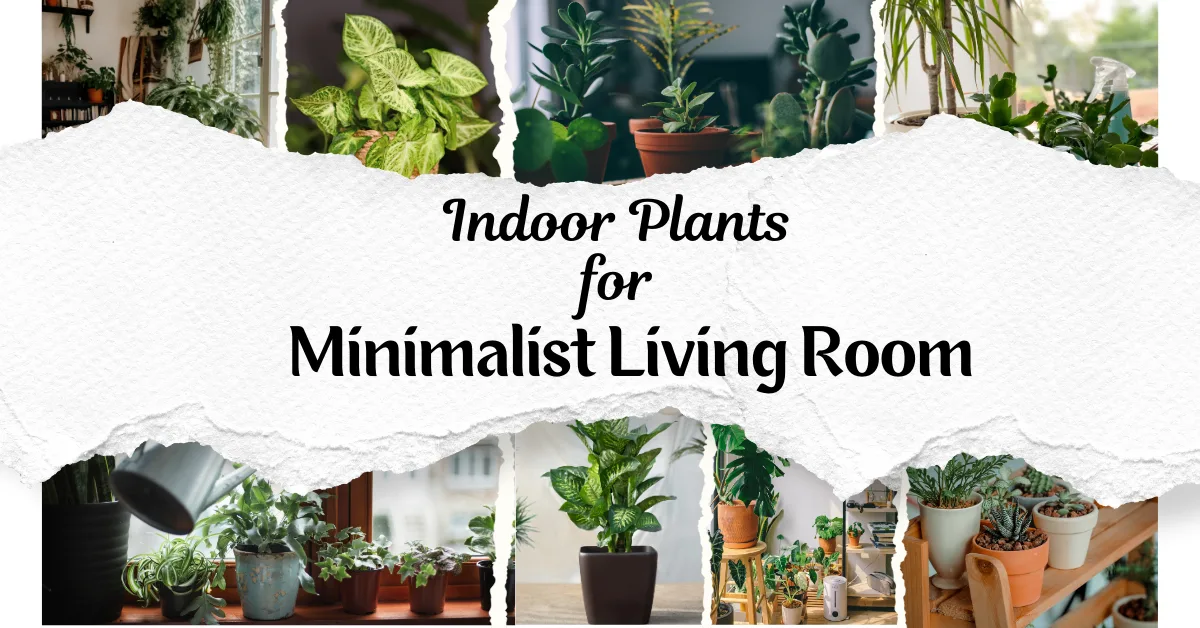A minimalist living room is incomplete without indoor plants. These natural elements not only bring life and vibrancy into your space but also create a calming and serene atmosphere. By incorporating indoor plants, you can enhance the aesthetics of your living room while maintaining a clean and uncluttered look that aligns with minimalist design principles.
Beyond their visual appeal, indoor plants offer numerous benefits. They help purify the air by filtering out toxins, improving indoor air quality, and promoting overall well-being. Whether placed in a cozy corner, on floating shelves, or as a striking centerpiece, the right plants can transform your minimalist living room into a refreshing and stylish retreat.
If you’re looking for indoor plants for a minimalist living room, lucky indoor plants, plants for living rooms without sunlight, or large statement pieces that make an impact, this guide covers the best choices to suit every need. Let’s explore the 10 best indoor plants that will enhance your minimalist living room with greenery, simplicity, and style!
Good Luck Indoor Plants for Minimalist Living Room
Having good luck indoor plants in a living room is a great way to combine minimalist aesthetics with positive energy. Lucky Bamboo, Money Plant, Jade Plant, Oxalis are best good luck plants for a minimalist living room that attracts prosperity, symbolizes good luck, and brings a positive vibe.
Bringing these lucky indoor plants into your minimalist living room, you can create a space that feels peaceful, refreshing, and filled with positive energy.
1. Lucky Bamboo
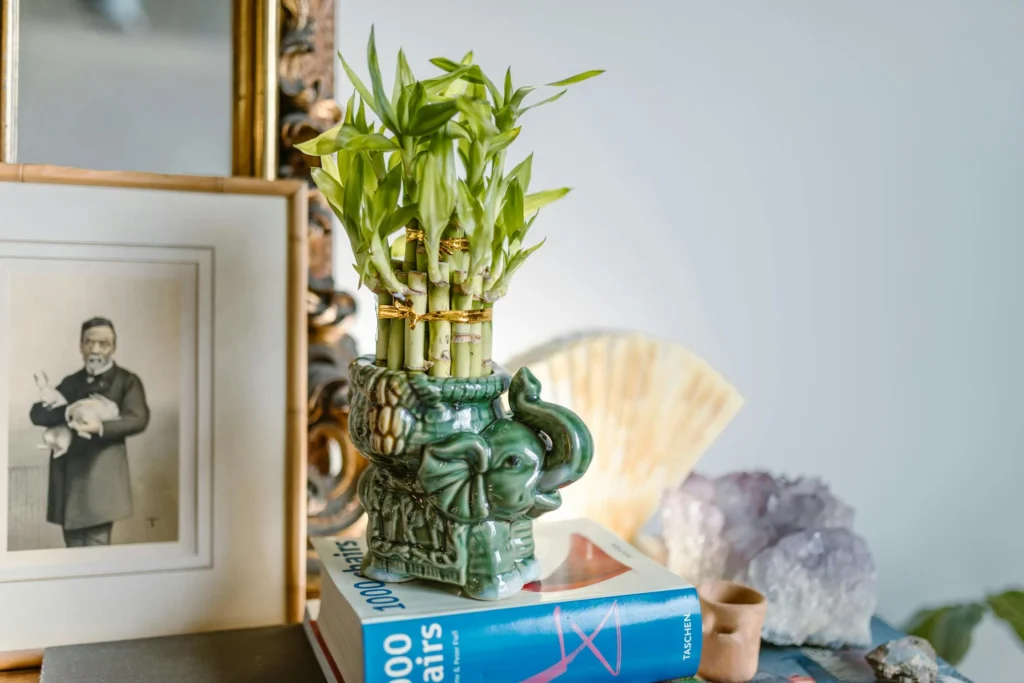
The word “Lucky” in the name of Lucky Bamboo really helps bring good luck and positive energy to your living room. In terms of Vastu Shastra, Lucky Bamboo has been considered as a symbol of prosperity, balance, good fortune, and positive energy.
The strong and straight growth of the lucky bamboo plant represents steady progress and resilience in human life. The number of stalks in lucky bamboo has different meanings.
- A lucky bamboo with two stalks attracts love.
- A lucky bamboo with three stalks attracts happiness.
- A lucky bamboo with eight stalks attracts wealth.
According to Chinese practice(Feng Shui), lucky bamboo is linked to five elements (wood, water, fire, earth, metal) which creates a balanced and positive environment in your minimalist living room.
Where Should We Place Lucky Bamboo for Best Result?
The placement and location of the lucky bamboo also plays a crucial role in maximizing your luck and spreading positive energy. The positive effects of lucky bamboo vary from place to place and from direction to direction. Here are some ideas that help you place lucky bamboo in the living room for best results.
- Place Lucky Bamboo in the southeast direction for financial growth and prosperity.
- Place Lucky Bamboo in the east direction for good health and family growth.
- Keeping Lucky Bamboo near the front door of your living room invites good energy.
Caring Tips for Lucky Bamboo
Implement the following caring tips to ensure healthy and vibrant growth of Lucky bamboo.
- Lucky Bamboo thrives in water. Use filtered or distilled water instead of tap water.
- Change the water every 7–10 days to prevent bacteria buildup.
- Avoid direct sunlight, keep it in bright, indirect light.
- Trim yellow or brown leaves to keep the plant looking fresh.
- If growing in water, ensure the roots are submerged but not too deep.
- If growing in soil, use a well-draining potting mix.

2. Money Plant
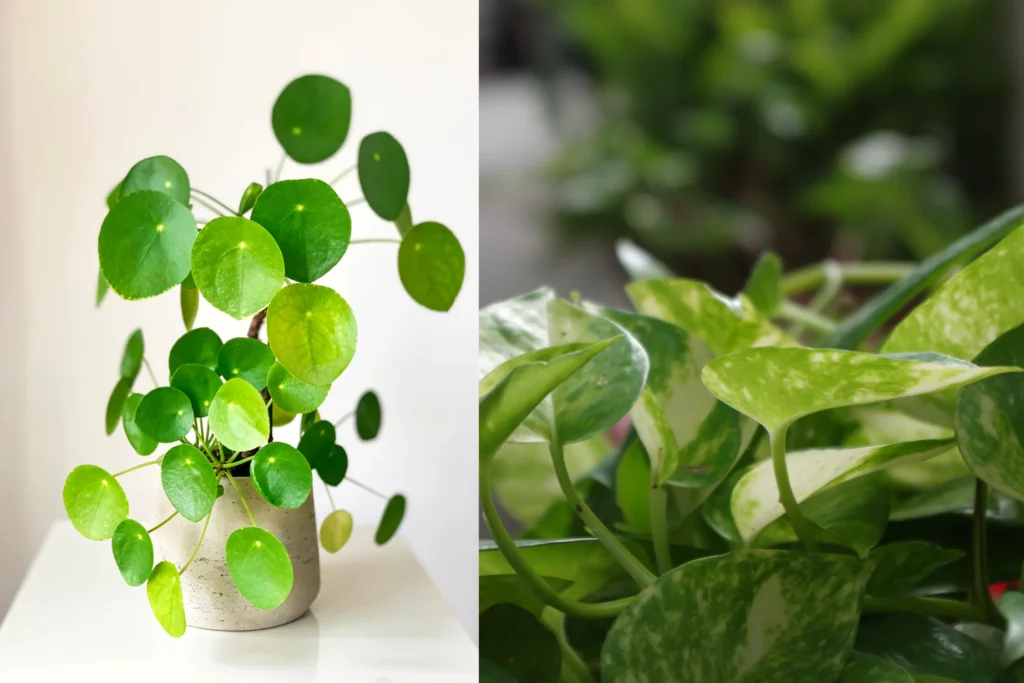
The Money Plant is considered one of the luckiest indoor plants in Feng Shui and Vastu Shastra. Money plants are easy to grow & maintain indoor plants which can thrive in various conditions.
Money plants create a peaceful environment by removing negative energy from your living room. It is also believed that the money plant helps in bringing wealth and positive energy into your life. The fast-growing vines of the money plant represent steady financial progress and continuous prosperity.
Where Should We Place Money Plants for Best Result?
The type of positive impact and benefits it makes on your life depends on the location and direction in which the money plant is placed. Here are some ideas that help you place Money Plants in the living room to enhance luck and benefits:
- Place Money Plant in the Southeast direction of the living room to attract financial growth and abundance.
- Avoid placing Money plants in Northeast direction since it may cause financial instability, as per Feng Shui principles.
- Positioning it near the front door attracts positive energy and good fortune.
Caring Tips for Money Plant
Money plant is one of the best low-maintenance living room plant, but a few simple care steps will keep it thriving:
- Avoid direct sunlight, as it can scorch the leaves. It can thrive in indirect sunlight or even in low light.
- Water every 7–10 days when the top inch of soil feels dry.
- A mix of garden soil, sand, and compost is the best soil type.
- If the Money plant is grown in water, change the water every two weeks to keep it fresh.
- Trim overgrown vines to maintain shape.
3. Oxalis
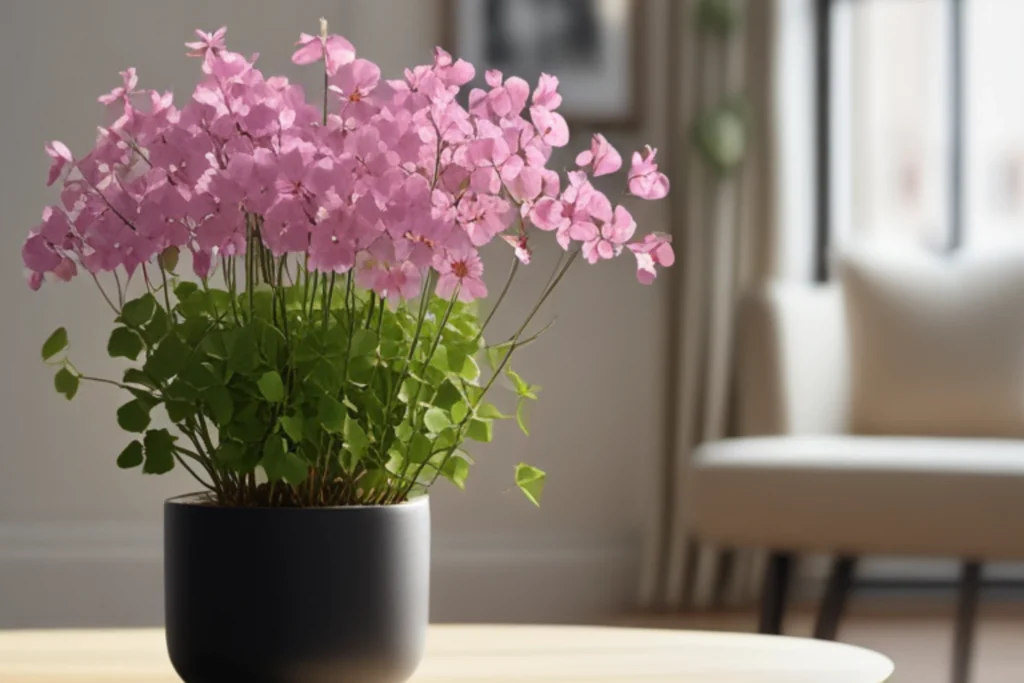
Oxalis is also known as Wood Sorrel or Lucky Shamrock plant. Its three- or four-leaf clover-like foliage has deep cultural and symbolic meanings, making it a perfect plant to combine good fortune and minimalist aesthetic in your living room.
Each part of Oxalis plant like leaves, flowers and foliage contribute to its lucky and aesthetic appeal.
- The unique triangular or heart-shaped leaves attract harmony, balance, and good fortune. Oxalis with four-leafs is rarely found and is believed to be much luckier.
- White, pink, or purple flowers add an elegant and peaceful touch to your minimalist living room.
- Oxalis leaves open during the day and are closed at night. This natural movement symbolizes a sign of new beginning, growth, energy flow and adaptability.
Where Should We Place Oxalis for the Best Results?
Choosing a perfect direction and location is crucial to get maximum benefits and avoid the negative impact of Oxalis plant. Here are some ideas that can help you to place Oxalis for best results:
- Place Oxalis in the East or Southeast corner of the living room for good luck, health, and financial prosperity.
- Placing Oxalis near a window with indirect sunlight enhances positive energy flow, attracting luck and good vibes.
- Placing Oxalis near reading nooks to encourage peace & motivation while reading.
Caring Tips for Oxalis
- Avoid direct sunlight to Oxalist. Place it in bright, indirect light to prevent leaf burn.
- Feed it with a diluted liquid fertilizer once a month during its growing season.
- Keep the Oxalis away from heaters or AC vents.
- Trim any yellow or dried leaves for fresh growth of Oxalis.
- Prefer repotting every 2–3 years to refresh the soil and prevent the plant from being too crowded.
- Avoid overwatering and keep the soil moist but not soggy.
Minimalist Indoor Plants for Living Room
Minimalist decor follows the philosophy of “less is more”, and the right plants can enhance this style. Minimalist indoor plants have clean lines, simple forms, defined shapes, or soft flowing greenery that fit well in minimalist spaces.
Minimalist plants require low-maintenance, less frequent watering and can thrive on minimal care. These low-maintenance minimalist plants help in purifying the air by removing toxins and promote a healthier indoor atmosphere.
A well-chosen minimalist plant with geometric shapes (like Snake Plants) or soft, trailing vines (like Pothos) not only complement minimalism but also create visual balance. The greenery created by these plants contrasts beautifully with white, beige, grey, and black minimalist interiors.
4. Snake Plant
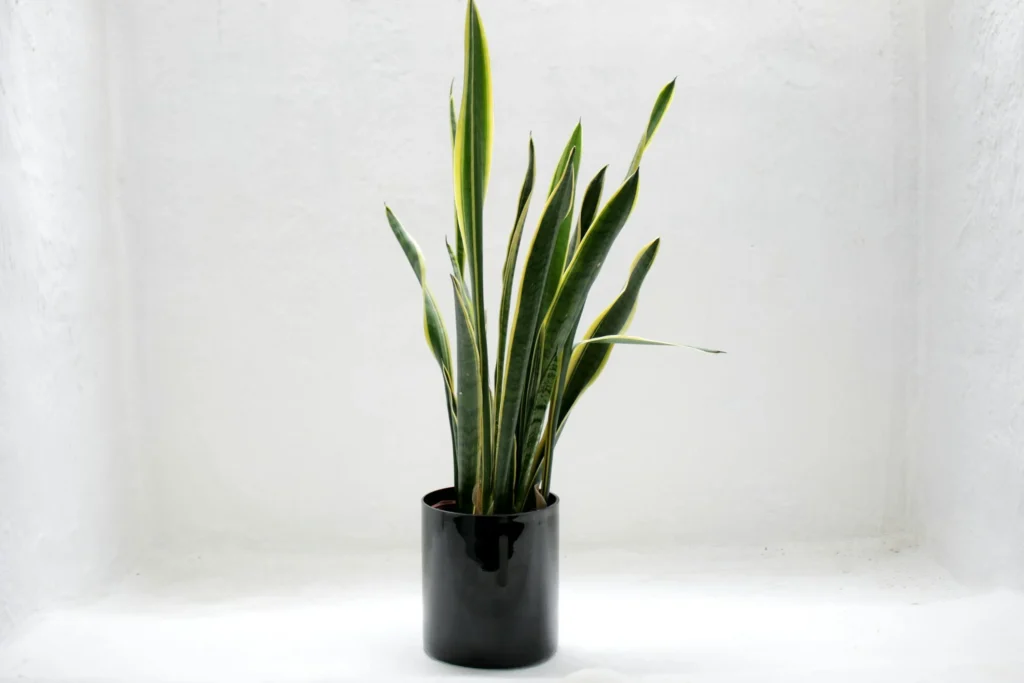
The Snake Plant (Sansevieria) is a perfect addition to a minimalist living room due to its sleek, vertical structure, upright leaves, low-maintenance nature, and air-purifying abilities. Snake plants have structured leaves with clean lines that add an elegant & minimalist aesthetic into your living room.
Snake plant takes up very little floor space which is perfect for a compact minimalist living room. Snake plants can thrive in any lighting condition whether in a low light corner or sunny windows.
Unlike other plants, Snake plant doesn’t require frequent watering. It can store water in its thick, fleshy leaves and needs water only once every 2–3 weeks.
Snake plant grows slowly and doesn’t outgrow its pot quickly so there is no need for frequent repotting. So it effortlessly enhances your minimalist living room while requiring almost no care.
Where Should We Place the Snake Plant for the Best Results?
- Near an east or west-facing window:- Provides bright, indirect light, which is ideal for growth of Snake Plants.
- Placing Snake Plants near the TV or electronics improves air quality of the living room by absorbing toxins released from appliances.
- Placing a tall snake plant next to Sofa or Bookshelf adds an elegant, structured look to empty spaces.
Caring Tips for Snake Plant
Although snake plant requires low-maintenance and less efforts for caring but it is necessary to consider following caring tips to keep it healthy and thriving:
- Overwatering can cause root rot so water only once every 2–3 weeks.
- Snake plants can thrive in low light, indirect light but grow best with moderate brightness.
- Snake Plant prefers temperatures between 60–80°F so you should avoid placing it near cold drafts.
- Snake plants grow slowly so repotting is only necessary when roots outgrow the pot, usually every 2–3 years.
- To maintain a clean & healthy look, trim the snake plant’s leaves only when they are damaged or turned into yellow.
5. ZZ Plant
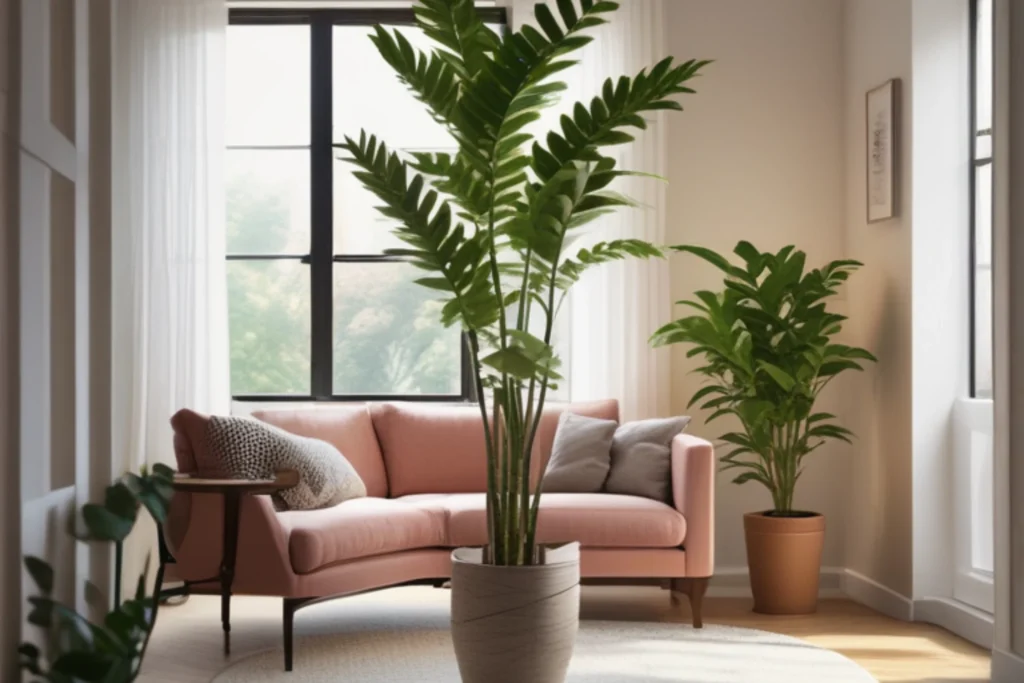
The ZZ Plant (Zamioculcas zamiifolia) is a perfect addition to a minimalist living room. Its glossy, dark green leaves and structured growth adds a minimalist aesthetic to the living room while maintaining modern look & clutter-free space.
ZZ Plant is a perfect low-light minimalist living room plant since it can survive in no sunlight or low-light conditions. It can also easily thrive well in dim corners where other plants struggle.
Due to easy to care and low-maintenance nature, it has been a great choice for minimalists who want beauty without effort. ZZ Plants have thick, water-storing rhizomes which make them highly drought-tolerant and require watering only once every 2–3 weeks. They are rarely affected by pests so homeowners don’t need to spread insecticides/pesticides like other plants.
Where Should We Place the ZZ Plant for the Best Results?
- Near a Window with Indirect Light to prevent scorch in leaves.
- Place a ZZ plant next to a Bookshelf or TV Stand that adds a natural touch to modern furniture.
- Placing a ZZ plant near the entrance of the living room attracts positive energy and prosperity.
ZZ Plants Caring Tips
Homeowners don’t need to make a great effort to care for this low-maintenance minimalist indoor plant. But requires very little effort to keep this plant healthy and beautiful.
- Water only once every 2–3 weeks.Let soil dry completely between waterings.
- Avoid direct sunlight since it can thrive in low light, indirect light, and even artificial lighting.
- Keep the temperature of the living room between 18–27°C.
- Cactus/succulent soil works best for ZZ Plant.
- Wipe the glossy leaves and remove yellow leaves to remove dust and keep it clean.
- Feed the ZZ plant with diluted houseplant fertilizer once in spring/summer.
6. Rubber Plant
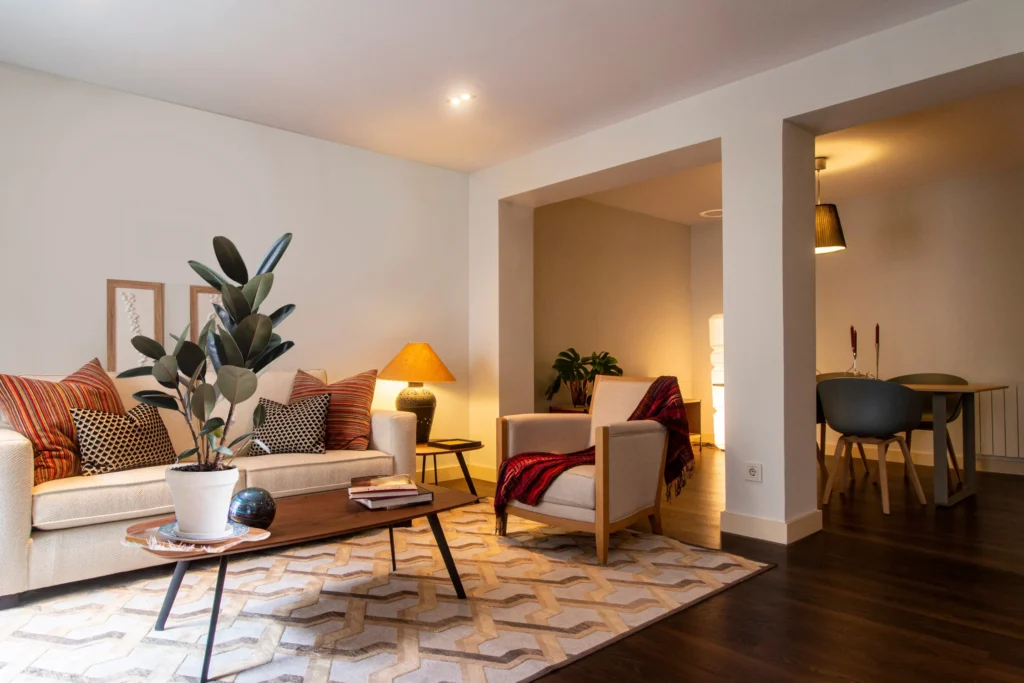
Rubber Plant is the ultimate low-maintenance minimalist plant for Living Room due to its bold leaves and structured growth. Whether you place it in a corner, near a window, or as a tabletop accent, it effortlessly enhances minimalist decor with its lush foliage and effortless upkeep.
The large, dark green (or burgundy, in some varieties) leaves add a striking visual element. These large, waxy leaves act as natural dust filters by trapping airborne particles.
Rubber plant also improves air quality & improves humidity by releasing moisture and increasing humidity through its leaves. As a result, you will get a dry, clean living room where fresh air always flows.
Rubber plant is more famous among minimalist homeowners due to its versatile nature. You can keep this plant compact or grown into a tall statement piece on the basis of your decor needs.
Where Should We Place the Rubber Plant for the Best Results?
- Place the Rubber Plant in a Spacious Corner since its tall, upright growth makes it perfect for filling empty spaces stylishly.
- Placing a medium sized rubber plant near Bookshelf or TV unit adds a refreshing natural contrast.
- Placing a small sized rubber plant on a floating shelf or console table can enhance minimalist shelves without looking cluttered.
Rubber Plant Caring Tips:
- Let the top 1-2 inches of soil dry before watering.
- Clean the leaves monthly to keep them shiny.
- Trim leggy or yellowing leaves to maintain shape and structured appearance.
- Repotting is only necessary when roots outgrow the pot(every 2-3 years).
Large Indoor Plants for Minimalist Living Room
Large indoor plants are tall, bold-statement making house plants that typically grow over 4–6 feet in height and have a significant presence. They are perfect for filling empty corners, adding greenery, enhancing clutter-free and minimalist aesthetics.
These big indoor plants bring a natural and refreshing aesthetic to the living room. Their lush green leaves create a calming and serene environment. Many large plants also help in improving indoor air quality by filtering toxins from the air.
Instead of having tall size, these tall indoor plants help in space optimization. They take up vertical space which is best for homeowners who want greenery in their small living room without cluttering the floor.
These plants can range from palms to bushy fiddle-leaf figs and can be placed in corners, near windows, or as statement pieces in a room. Fiddle Leaf Fig, Monstera Deliciosa, Bird of Paradise (Strelitzia nicolai), Dracaena Marginata are some popular examples of large plants for a minimalist living room.
7. Fiddle Leaf Fig
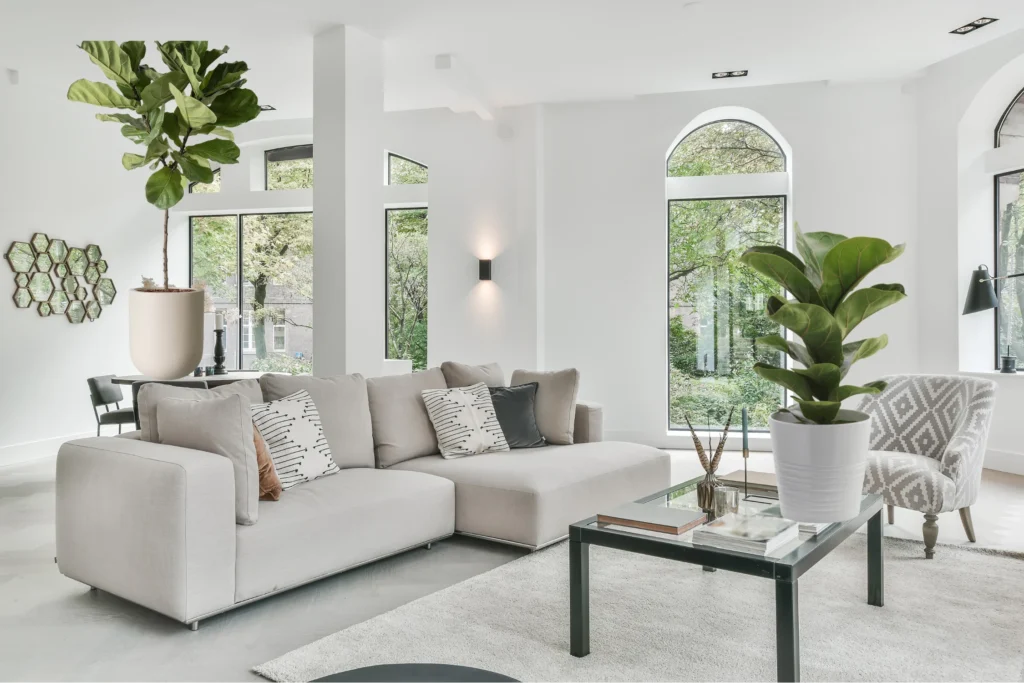
Fiddle Leaf Fig is a perfect tall plant that can make a bigger statement than multiple small ones. Its tall, upright trunk and large, structured leaves perfectly align with minimalist principles(clean lines and uncluttered layouts).
The vertical growth of the Fiddle Leaf Fig plant adds a tall & sleek design and makes a natural statement piece without cluttering your living room.
Minimalism follows the “Less is More” principle. A single fiddle leaf fig plant can fill empty spaces effortlessly without making the room feel crowded by eliminating the need for multiple small plants.
A minimalist living room is typically decorated with neutral tones like white, gray, beige, and black. The deep green, glossy leaves of this plant create a beautiful contrast against these neutral tones.
Where Should We Place Fiddle Leaf Fig in a Minimalist Living Room?
- Place Fiddle Leaf Fig in an empty corner which creates a balance and visual interest.
- Placing Fiddle Leaf Fig beside a natural wall, the deep green leaves contrast beautifully against neutral tones.
- Placing Fiddle Leaf Fig next to a sofa or armchair adds a touch of nature while enhancing cozy seating.
- Placing Fiddle Leaf Fig near the TV or media console softens the appearance of electronic devices and adds an organic touch to them.
Caring Tips for Fiddle Leaf Fig
- Place it near a large window for bright, indirect sunlight.
- Avoid overwatering.
- Fiddle Leaf Fig plant prefers moderate to high humidity. Mist occasionally in dry conditions to maintain humidity.
- Keep repotting every 1-2 years to provide fresh soil.
- Wipe the large leaves occasionally to keep their leaves glossy and healthy.
8. Monstera Deliciosa

Monstera Deliciosa, also known as the Swiss Cheese Plant, is a tall indoor plant that adds maximum impact to your living room with minimal effort. The large flowing leaves of Monstera Deliciosa softens the minimalist look by breaking the monotony of straight lines and sharp edges.
Minimalist living room design emphasizes simplicity, balance, and natural elements. Monstera perfectly has a light, open structure that aligns with this aesthetic by adding a touch of nature without overwhelming the space.
The organic shape, natural form of Monstera plant pairs beautifully with the modern, minimalist furniture. The deep green foliage of Monstera is perfect for neutral spaces or wood-toned backgrounds.
A single Monstera can create a natural focal point since it quickly fills an empty space with lush greenery by replacing excessive decorative items. Monstera plant acts as a biophilic design element since it enhances a natural, refreshing atmosphere which is also a key to modern minimalist aesthetics.
Where Should We Place Monstera Deliciosa in a Minimalist Living Room?
- Near a Window with Indirect Light to prevent leaf burn.
- Placing this tall, structured and fast growing Monstera plant in a corner can quickly fill an empty space elegantly.
- Placing Monstera against a plain wall can convert an empty wall into natural wall art using its large, dramatic leaves.
- Placing Monstera beside a TV stand or bookshelf adds an organic contrast.
Caring Tips for Monstera Deliciosa
- Monstera Deliciosa loves moderate to high humidity so mist this plant only when the air is too dry.
- Avoid direct sunlight since Monstera prefers indirect light.
- For the healthy and controlled growth of leaves, trim the damaged leaves.
- Since Monstera Deliciosa is a tall indoor plant, it needs support to maintain its upright shape. Use a moss pole or stake for support as it grows.
Small Indoor plants for Living Room Corner Decoration
If you have a small living room or just want to decorate a cozy corner, small indoor plants can be a perfect choice. They add a refreshing touch of greenery without taking up too much space while enhancing the beauty of your living room.
A well placed small indoor plant not only creates a focal point but also makes the corner more attractive. Most of the small plants require minimal care so you can mix different small plants for a unique look.
Rubber plant, Parlor Palm, Watermelon Peperomia, String of Pearls are some of the best small indoor plants that would fit perfectly in a living room corner.
9. Parlor Palm
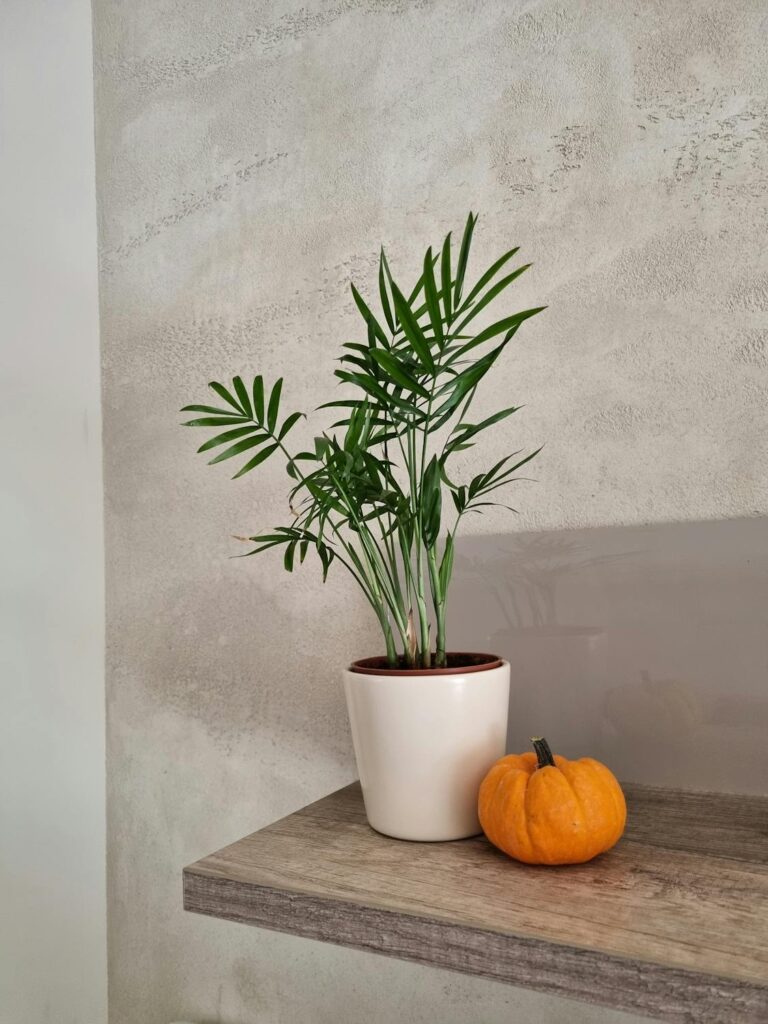
Parlor Palm is one of the best small indoor plants for decorating a living room corner due to its graceful appearance, low maintenance, and ability to thrive in indoor environments. Its feathery, arching fronds bring life and movement to the corner.
Unlike larger palms, it fits well in small to medium corners without overwhelming the space. Parlor palm plant has slender and bushy growth which makes it perfect for small corners.
If your living room corner lacks direct sunlight then Parlor Palm could be an excellent choice for you. Since it can grow well even in shaded corners.
Beyond the decoration benefits, it helps in purifying the air by removing toxin elements from air. The greenery added by this plant also helps in reducing stress and promotes a peaceful environment.
Caring Tips for Parlor Palm
- Low to bright indirect light is best for Parlor Palm.
- Water once a week in warmer months and every 10–14 days in winter.
- 18–27°C Temperature is best for Parlor Palm to survive in the corner.
- Mist the leaves occasionally or place a humidifier nearby to maintain humidity in the pot.
- Use a well-draining potting mix with peat and perlite.
- Apply diluted liquid houseplant fertilizer once a month in spring and summer.
10. Watermelon Peperomia
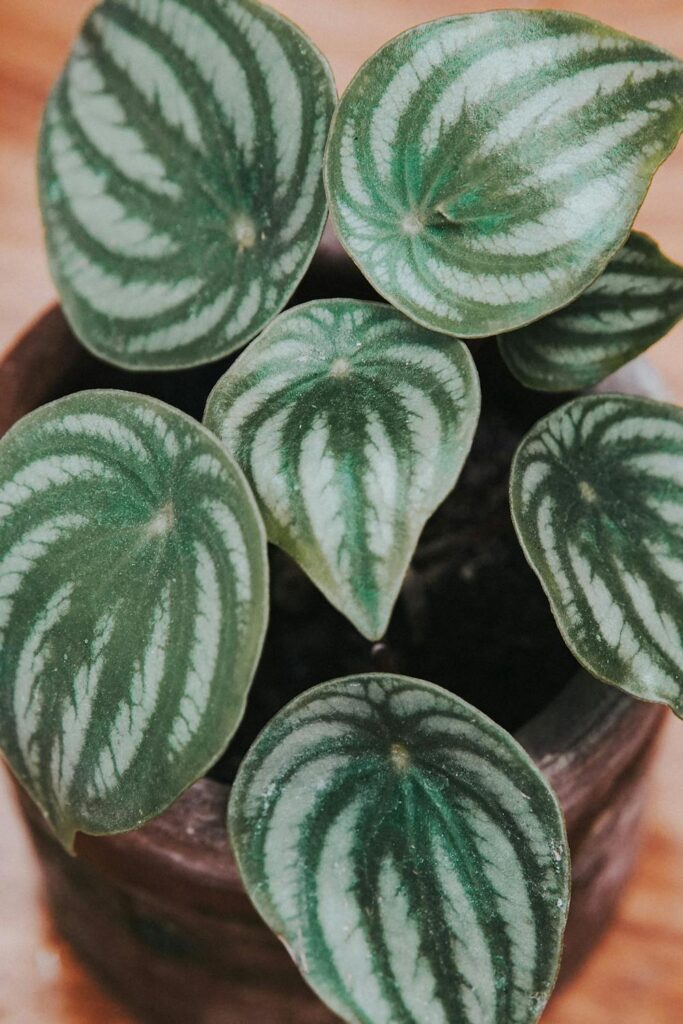
Watermelon Peperomia is a great choice for living room corners or small spaces due to its compact size, striking leaf pattern, and low-maintenance nature. Its round, silver-striped leaves resemble a watermelon and add a unique aesthetic appeal to the living room.
Watermelon Peperomia is a great choice for areas like living room corners where sunlight is limited. The vibrant, patterned leaves can reflect light and brighten up darker corners.
Watermelon Peperomia pairs well with other indoor plants to create a vibrant, textured display. Watermelon Peperomia adds a stunning look to the living room corner when grouped with trailing plants like Pothos.
Caring Tips for Watermelon Peperomia
- Prefers bright, indirect light but can tolerate low light.
- Avoid direct sunlight to prevent leaf burn.
- Prevent overwatering since it can cause root rot. Watering once a week is best for this plant.
- Trim damaged or yellow leaves to keep the plant healthy.
- Watermelon Peperomia loves humidity! Use a humidifier or mist this plant occasionally to maintain humidity.
Conclusion
Decorating your minimalist living room with indoor plants not only adds greenery but also improves air quality, maintains humidity in air, brings good luck and enhances aesthetics. All these indoor plants require low-maintenance and offer a variety of choices to match different styles, lighting conditions. With proper care, they not only survive but thrive, bringing long-term beauty and wellness benefits to your home.
Which plant will you add to your living room? Let us know in the comments!
Frequently Asked Questions (FAQs)
-
What are best indoor plants for living room?
Snake Plant, ZZ plant, Oxalis, Lucky Bamboo, Money Plant, Rubber plant, Fiddle Leaf fig, Monstera Deliciosa, Parlor Palm and Watermelon Peperomia are some best indoor plants that transform your minimalist living room into a refreshing and stylish retreat.
-
What are good luck plants for living room?
Lucky Bamboo, Money Plant, Jade Plant, Oxalis are best lucky indoor plants that brings positive energy and attracts prosperity to your home.
-
What are minimalist indoor plants for living room?
Peace Lily, Snake plant, ZZ plant, Pothos, Prayer plant, Spider plant, Birds of paradise flower are some of the best indoor plants that follows the minimalist principle.
-
What are large indoor plants for living room?
Fiddle Leaf Fig, Monstera Deliciosa, Bird of Paradise (Strelitzia nicolai), Dracaena Marginata are some large indoor plants for minimalist living room.

Hello there, my name is Anil Pun Magar and I am founder of this blog (MinimalAura). I have 5 years of working experience in home decoration field. As the founder of MinimalAura, I am sharing insights on modern minimalist living, home organization, and aesthetic interior design. My aim is to inspire a lifestyle that blends functionality with beauty.

